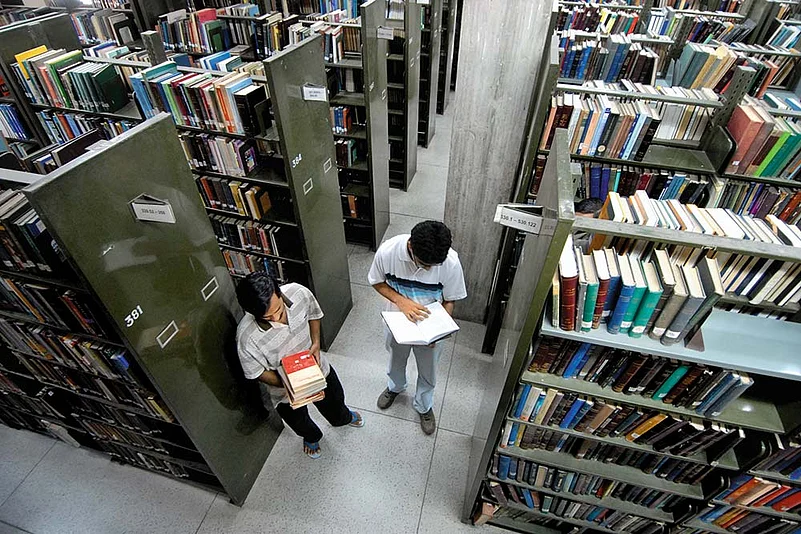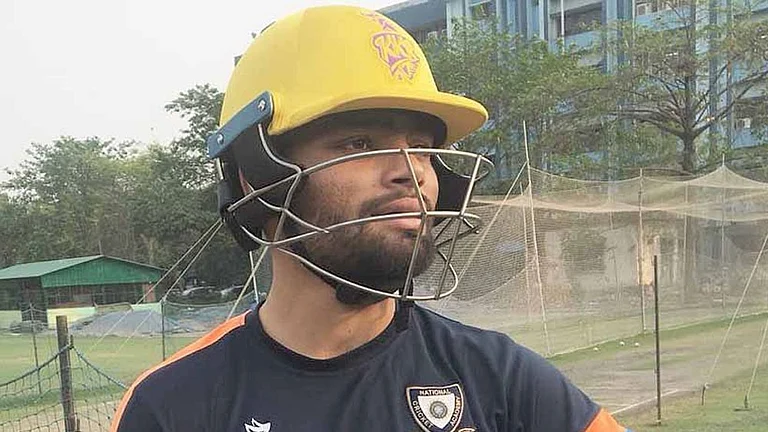Ever since the pandemic stalled normal life six months ago—including the busy concourses of schools, colleges and universities—there has been a great deal of reflection about how education can be reimagined as something delivered through the internet and in virtual spaces. Schools started shifting to online classes in April—a change that’s here to stay, according to experts. The same month, the UGC altered the year’s academic calendar—central to its plan is shifting curricula and exams fully or partly online. Since March 24, the e-learning platform SWAYAM, run by the education ministry, has seen 50,000 new enrolments. The user base has tripled in several other NCERT-run online learning platforms. The National Digital Library is also being accessed by twice the usual number of subscribers daily. There is excited speculation all around about the promise held out by e-learning. However, there are also profound doubts and criticisms—partly on the logistics of the online model, and especially relating to internet access and whether India can really ensure equitable distribution of education across social strata and in non-urban zones.
The 2011 census tells us 31 per cent of the Indian population is between five to 19 years of age, the school-going age—the bulk of them with a basic right to education under the RTE Act. As of 2016-17, some 1.5 million schools in India reported a total enrolment of 25.1 million students, including about 5.8 million in government schools.
The total enrolment in higher education is 37.4 million, and women make up around half of that. In short, a staggeringly vast size has to be provided for.
What is good teaching? This is one of the most fundamental questions. Once we can elucidate some benchmarks and principles of good teaching, it would be then suitable to ask whether there is infrastructural, logistical and social feasibility of adapting these for online with immediate effect, and whether that will be sustainable for all in India. Teaching is not about engaging in a one-way didactic delivery of concepts through lectures, but a process of active interaction between an educator and a learner. The learning environment is an important moderator of learning outcomes.
Broadly, we can conceptualise an educator’s communication as comprising ‘verbal’ and ‘non-verbal behaviours’. While ‘verbal’ refers to what and how a teacher says what she says, ‘non-verbal behaviours’ are now seen as a critical variable in communication—those that “increase ‘sensory stimulation’ and produce ‘interpersonal closeness’”.
The effect is called ‘non-verbal immediacy’. Think of these: reductions in proxemic distance; increases in touch and eye contact; positive facial expression, especially smiles, and positive head nods; relaxed body posturing, and attire and gestures that embed a live context in salient ways; purposeful body movements; the presence of other interactants, which automatically orients one’s head and body towards them; vocal expressiveness; specific alterations of pitch and tone in response to a live speech context.

With decades of research efforts, these have been organised into the domains of kinesics (body language), proxemics (the study of the human use of space and distance), haptics (physical environments, touch), chronemics (use of time), oculesics (eye contact and actions of looking while interacting, frequency of glances, patterns of fixation, pupilary dilatation and blink rate), vestemics (clothing style, appearance) and paralanguage (voice quality, rate, pitch, volume as well as prosodic features such as rhythm, intonation and stress). Non-verbal immediacy has long been associated with the affective component of learning, which deals with attitudes to learning, such as interest and engagement. However, researchers had initially struggled to establish its relationship with cognition itself in early childhood or primary education. This was somewhat of a baffling gap, given how acutely aware even pre-schoolers are to facial expression and body language changes in parents and caregivers. It was not until the late 1980s that this conundrum could be resolved.
In a landmark study, Richmond and McCroskey showed that all studies that failed to associate cognitive learning to non-verbal immediacy were conducted in too straitjacketed a manner—focusing on textbook, workbook, guided instructions—hardly veering out of those narrow parameters of judging. Seen that way, it seemed perfectly possible for students to meet all learning objectives and attain good scores even without attending classes, or being engaged in them. Once non-verbal immediacy was assessed in classes that had a more open approach, it emerged as a significant predictor of student’s cognitive learning as well. Two other studies strengthened the association by establishing clarity of verbal communication and teacher’s humour orientation as key predictors of learning outcomes.
The construct of non-verbal immediacy has since also been validated cross-culturally, and revalidated in a 2018 study with a much larger and more diverse sample. In fact, it’s suggested that non-verbal immediacy can supersede verbal communication in how messages are interpreted by students in classrooms. The evidence stands further bolstered with extremely young children—even five-year-olds—successfully using non-verbal cues to infer social relationships with a power hierarchy. Children in kindergarten seem to make use of complex non-verbal cues while deciphering the meaning of instructional videos more than verbal messaging itself. A voluminous body of research literature thus links non-verbal immediacy positively to learning outcomes in early childhood. Years of research in communication theory and educational psychology have now established it as a key factor in determining learning outcomes, both cognitive and affective, in higher education as well. It has been linked to how teacher performance is evaluated by students—and vice versa.
Apart from non-verbal cues, the importance of visual information in teaching is paramount. Children can be taught various cognitive and motor skills using visuo-spatial, auditory, tactile or kinaesthetic stimuli or inputs. The learning environment, interaction with the teacher and peer relationships also develop social skills. An integrative, interactive teaching system certainly fares better in terms of overall development of the students. This is broadly consistent with human neuroanatomy: most of the cerebral cortex is devoted to assimilation and complex processing of various sensory modalities. In higher education, it has been demonstrated that multimedia-based content, especially audiovisual stimuli combined with text, maximises student learning, even as several different learning styles are controlled for. Visual literacy is now almost a built-in technological tool, especially in higher education in STEM (science, technology, engineering and mathematics) fields.

Can this be done online? It is imperative here that while verbal, visual and textual information can be presented online with the aid of slides or virtual whiteboards, non-verbal immediacy is far more challenging to emulate even in a live lecture when face-to-face interaction is absent. The field has evolved in developed nations, but even with adequate internet infrastructure, most experts agree online pedagogical skills need special training, and tailored course content and delivery. Humans tend to have shorter attention spans while attending online lectures, and most pedagogic practitioners suggest video lectures of less than 10 minutes for college-level students. Children with even shorter attention spans probably need even shorter videos compared to classroom lectures. The content also needs to be developed with careful attention given to built-in live interaction.
In retrospect, online teaching seems to be more challenging for even seasoned educators and most courses taught before have to be completely redesigned for this kind of education. It can take weeks to months to properly adjust one’s pedagogic style. If online classes are to replace classroom teaching en masse, it would mean a complete recalibration of the curriculum and extensive teacher training. The number of school teachers in India is estimated at 89 lakh; add approximately 14 lakh college educators. It is easy to envision the Herculean scope of this task.
The second mandatory requirement in quality online pedagogy is not just access to internet, but access to reliable, stable and high-speed internet. If all the non-verbal immediacy behaviours are to be replicated bidirectionally, it would require all students as well as teachers to have access to high bandwidth internet for a few hours, on a regular basis. While internet-enabled smartphone usage is definitely on the rise in India’s urban and peri-urban spaces, access to internet, bandwidth issues and speed, as well as cost of data, are all key variables to keep in mind vis-à-vis online education. TRAI statistics tell us overall internet penetration in India in early 2020 was around 52.08 per cent, with rural net penetration at just 27.5 per cent, indicating that approximately half the country and over 70 per cent of the rural demographic do not have internet access. This is worrisome because 60 per cent of our colleges and 80 per cent of schools are rural.
There’s also a stark gender gap: access to phones and internet is lower among women and girls (43 per cent overall) than men and boys (80 per cent)—that’s half. Also, broadband and wired connections make up only about 5 per cent of the user base; mobile internet accounts for over 95 per cent. And when it comes to mobile internet speeds, India is abysmal— as of May 2020, it ranks 127th among 140 countries. An average mobile internet download speed of 11.4 Mbps, against a global average of 33.7 Mbps, makes it the worst among APAC countries. None of the Indian telecom operators can match the global average in 27 out of 28 telecom circles.
These facts and figures indicate that internet in India simply does not have the reach to cater to all students in the public education system. Since August 2019, Kashmir has been on a lockdown and now the allowed internet speeds are completely inadequate to deliver any form of online education. A large part of India, by default, is in the same place.
Quality online education requires enterprise-level internet connections, wired or wireless. A video conference with five participants would need a download speed of 2.5 Mbps, the required bandwidth being proportional to the number of participants. Extrapolate that to the average teacher-to-student ratios in Indian schools and colleges—1:28 and 1:29 respectively. That means each teacher would require a connection with download/upload speeds of around 12-15 Mbps. As of now, mobile connections in India would be hard-pressed to meet this demand—especially with average network speeds in peak hours dipping 36 per cent during the lockdown compared to February. Anyway, only 42 per cent of India’s internet users have connection speeds over 4 Mbps; only 10 per cent enjoy a speed over 15 Mbps.

The National Telecom Policy 2012 envisaged extending broadband internet to every village by 2020, with a minimum download speed of 2Mbps. The project, the brainchild of India’s telecom pioneer Sam Pitroda, was rebranded in 2015 as Bharat Net, with a humbler goal of enabling India’s 2.5 lakh panchayats, purported to cover over 6 lakh villages. The promise is far from being fulfilled: by November 2018, less than 2.5 per cent of panchayats were reported to have commercial broadband connections enabled.
Now let’s match the two scenarios. Experts say most home internet connections in India are unsuitable for conducting online lectures and video conferences—they are plagued by poor upload speeds, which are typically lower than download speeds. This means providers like Google Meet or Zoom will ‘downsample’ the video and audio to accommodate suboptimal speeds. Result: extremely poor quality for students. And what does that do to non-verbal feedback for teachers? Well, most teachers have to switch off video feeds from students, especially with class sizes beyond 10, which means they simply have to forego this vital resource. From personal experience, just half a semester of online teaching opened my eyes to how important this feedback is to gauge whether the class is engaged or not. Recording a video lecture often feels like talking to a vacuum. Incorporating real-time humour and other communication tools is largely impossible. And student feedback speaks of a commensurate loss of quality at their end.
The infrastructure, thus, is grossly unprepared to support a wholesale shift online, from the perspectives of both educators and learners. Symmetric outcomes will take enterprise-level connections for educators, to support adequate upload speeds, so that high-quality streaming content reaches all students simultaneously. The evolution of infrastructure—with fibre-optic cables ensuring last-mile connectivity—will probably take months, if not years.
As a parent, watching my second-grader trying to keep up with his online classes, I discovered a second set of problems. Kids are, of course, more familiar with computers than previous generations, but navigating Zoom, MS Teamwork and Google Meet effectively is still quite challenging for preschool, kindergarten and primary school children. Parents (often working parents) have to continuously log them in, attend to connectivity problems, and follow Whatsapp groups for backup notifications and homework, all being administered over different apps. Moreover, most teachers seem to simply repeat their classroom teaching in front of a computer: it’s clear that they have no training or preparation in online teaching methods. Classes are also cancelled frequently. Third, children can develop impeded focus by engaging with smartphones and screens longer than a few minutes at a time. I am actually worried that this new trend of making children sit and interact with computers for 3-4 hours every day will ultimately affect their concentration, eyesight as well as general well-being negatively. In making touch-sensitive devices, apps and internet so freely available to young children and adolescents, there is also a huge risk of fostering internet addiction.
(All the data used is from official sources. Views are personal.)
Assistant professor of psychology at Ashoka University






















